Mike Morton (geologist)
| Mike Morton | |
|---|---|
 | |
| Born |
Michael Douglas Morton 11 July 1924 Huddersfield, England |
| Died |
(aged 79) Llansantffraid-ym-Mechain, Wales |
| Nationality | British |
| Fields | Geology |
| Institutions | Iraq Petroleum Company, Canadian Industrial Gas & Oil Ltd, Marathon Oil Corporation, Hunt Oil, World Bank |
| Alma mater |
Huddersfield Technical College Leeds University |
| Known for | His expertise in the petroleum geology of the Middle East |
Douglas Michael "Mike" Morton (11 July 1924 – 22 November 2003) was a British petroleum geologist and a leading authority on the geology of the Middle East.
Background and education
Morton was born in Huddersfield, England, on 11 July 1924. He took a degree in geology at the Huddersfield Technical College and completed his studies at Leeds University, graduating in the summer of 1945. At this time, the Iraq Petroleum Company (IPC) was looking to recruit geologists as part of recommencing of its oil exploration operations in the Middle East. Morton applied for the post of assistant geologist and was appointed in the autumn of that year to take up his duties in Palestine and Transjordan.[1]
Career with the Iraq Petroleum Company
Palestine, Transjordan and Syria
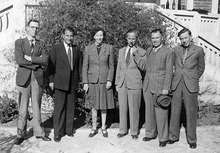
IPC operations encompassed all parts of the Middle East within the limits of the defunct Ottoman Empire, according to the Red Line Agreement of 1928. The Company's geological department possessed a remarkable range and depth of talent with the result that Morton worked with distinguished geologists such as Jim McGinty, Sami Nasr, Louis Dubertret, Leo Damesin, R.G.S. Hudson, H.V. Dunnington, Ziad Beydoun, F.E. Wellings and Norval Baker.[2]
Morton's first posting was to IPC headquarters in Jerusalem, from where geological surveys were conducted across two countries, Palestine and Transjordan. The primary role of the geologists was to survey the terrain by mapping and plane tabling exposed rock formations. Field parties would venture from the main field camps, Kurnub (Palestine) and Mafraq (Trans-Jordan), setting up smaller tented camps, known as "fly camps" in the desert terrain. During this period, Morton became fluent in Arabic, which was essential for exploring the remoter regions of the Middle East.[1]
The search for oil in Transjordan was unsuccessful. In Palestine, although the company started drilling a test well near Gaza in 1947, drilling was suspended in February 1948 when political disturbances made it difficult and dangerous to carry on.[2]
In 1948, Morton was posted to Syria and, based in Aleppo, he took charge of a field party in the north-west of the country. "The most striking result of the work,’ wrote the geologist E. J. Daniel, ‘was to establish the occurrence of Jurassic limestone in the region ... the application of this work is more towards an understanding of the general geology of north-west Syria; and some useful information regarding the origin of the basic igneous rocks of the district, and also in respect of faulting, has been collected."[3]
IPC eventually abandoned oil exploration in Palestine, Transjordan and Syria without making any commercial discoveries.[4]
South-western Arabia
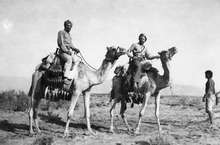
It was during this time that he worked with René Wetzel, a French geologist employed by IPC, and together they carried out many surveys together, including a series of ground-breaking expeditions to south-western Arabia (the Aden Protectorate and Dhofar) between 1947 and 1953.[5] At the start of their first expedition, in November 1947, they met the explorer Wilfred Thesiger who was about the commence his second crossing of the Rub' al Khali (the Empty Quarter). The subsequent expedition to the Mahra country (today's Yemen) was hazardous. The rugged terrain ruled out motor transport and the survey party had to travel by camel and dhow. Tribal tensions delayed their progress in Al Ghaydah as Morton and the expedition doctor were briefly held prisoner. Morton and Wetzel, together with IPC liaison officer, Major Tony Altounyan, went on to carry out a survey of Dhofar province, a province of the Sultan of Oman, Said bin Taimur. The resulting survey was completed in March 1948 and, on their recommendation, IPC abandoned the Dhofar concession in 1950.[1]
In 1949, they returned to the Aden Protectorates to carry out a survey of the territory around Shabwa and Beihan. In the autumn of 1953, Morton led a geological field party to the bedouin well at Thamud, in the Eastern Aden Protectorate.[1][6]
Iraq
Between 1947 and 1953, while not being employed in southern Arabia, Morton and Wetzel worked together in Iraq, carrying out extensive field work and mapping the Mesozoic outcrops. This work was later incorporated in the Stratigraphic Lexicon of Iraq[7][8] which remains a key reference.[9]
Pre-war geological investigations in Iraq had been suspended as a result of civil disturbances, and were not resumed until 1946 when 'a planned campaign of stratigraphic research was set afoot'.[10] Under the overall charge of Colonel Henson, the project involved a vast amount of fieldwork and laboratory studies. René Wetzel directed most of the work in Kurdistan, the Sinjar and the western desert, assisted by Morton and a number of other geologists such as Dr R.G.S. Hudson ('Doc'), Charles André, Harold Dunnington and Henry Hotchkiss over a period of six years. Deeper wells were drilled to locate older deposits: this resulted in oil being discovered in the Middle Cretaceous at Ain Zalah, Kirkuk and Bai Hasan.
Morton and Wetzel ran a number of photographic, stratigraphic and structural sections, and surveys, in various parts of Kurdistan, to define the attitude and composition of the strata within the concession areas. The information from these and measured sections led to a number of prospective oil-reservoir rocks being defined.[1]
Oman
In 1948, Morton was posted to Qatar and then to Oman. IPC was particularly interested in opening up a strategic mountain pass through the Wadi Jizzi. In February 1949, Morton took part in an expedition led by IPC Liaison Officer Edward Firth Henderson through the Wadi Jizzi which resulted in a shooting incident but no casualties.[11] This, together with the occupation of the village of Hamasa in the Buraimi Oasis by a Saudi Arabian contingent in 1952, led to IPC operations in central Oman being shelved.[1][12]
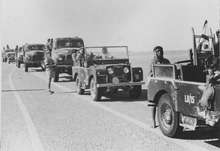
In February 1954 IPC renewed its efforts to explore central Oman with its "Operation DEF", a plan to land a party of oil company personnel and troops at Duqm on the southern coast. Morton, having been appointed to lead the geological field party from Duqm to Jebel Fahud in Oman, handed over the Thamud expedition to his colleague, Ziad Beydoun, to join the Duqm landings. The field party reached Jebel Fahud in October of that year.[12][13] During the next two years, while IPC drilled for oil at Fahud, Morton and his team of geologists and a surveyor, Nick Fallon, mapped the central areas of Oman. Although IPC's attempts to find oil in Oman were unsuccessful, Royal Dutch Shell as the major partner in the reconstituted company, Petroleum Development of Oman, subsequently located a major oilfield at Fahud which extended to within a few hundred metres of the original well.[14] In November 1955, a few days after the expulsion of the Saudi Arabian contingent from Hamasa, Morton and his field party reached Al Buraimi.[1][12]
In 1957, Morton was appointed Senior Geologist, Persian Gulf. In 1959, he attended the 5th World Petroleum Congress and delivered a paper entitled '’The Geology of Oman'’ which became a standard reference for those studying the geology of Arabia.[15] This was described by the Chief Geologist of IPC, N.E. Baker as "a major contribution to the geology of southern Arabia, ranking along with Lees' (George Martin Lees) early work on the geology of Oman."[16]
Qatar and Abu Dhabi
Morton first went to Qatar in December 1948 to work on Jebel Dukhan, the oil-bearing structure of that country. In 1962, he became head of the geological department of the IPC associate companies, the Qatar Petroleum Company (QPC) and the Abu Dhabi Petroleum Companies (ADPC). During this time the Bu Hasa oil field was discovered in Abu Dhabi. He moved to Abu Dhabi with his family in 1966, continuing in ADPC as review geologist, Persian Gulf, until his retirement from the company in 1971.[1]
Remaining career in the oil business
Musandam expedition
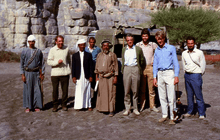
Later in 1971, Morton was appointed deputy leader of the Royal Geographical Society (RGS) expedition to the Musandam Peninsula in Oman. This followed the lifting of a 50-year ban on foreigners being allowed to visit the area on account of tribal sensitivities. The expedition, led by Norman Falcon FRS, formerly Chief Geologist with BP, was regarded as one of the Society's most successful in recent times,[17] although Falcon himself admitted that the terrain had made research difficult.[18] The party included geologists, biologists, archaeologists, ethnographers and surveyors and resulted in the publication of a number of important papers about the region.[19]
Consultancy work
In the 1972–73 season, Morton led an eight-man team of Mobil geologists to Oman and the United Arab Emirates. He then undertook varied consulting advice before being employed by Marathon Oil, Syria, in oil exploration. Between 1980–1, he advised the World Bank in respect of oil prospectivity in Turkey, and he was involved in a survey of the Marib area of Yemen for Hunt Oil which ultimately resulted in the discovery of the first oil field in that country, the Asif field, in 1984.[20]
The geology of Oman
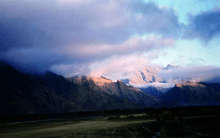
Morton's 1959 paper touched on one of the most intriguing aspects of the geology of Oman: how oceanic crust, known as the Semail Ophiolite, came to occur all around the Hajar mountains and Jebel Akhdar, the "Green Mountain". The theory supported by Morton and others – Tschopp (1967)[21] and Wilson (1969))[22] – was that these igneous rocks had essentially flowed into position. Lees (1928)[23] had earlier proposed a huge thrust sheet, the Semail Nappe, based on his observations in the Oman Mountains, and on his knowledge of the Alps and of the Zagros. As evidence of plate tectonics grew, a development of Lees' theory (Glennie (1974)) emerged.[24] This postulated that, as the continents moved together, a slab of ocean crust from the ancient Tethys Ocean had been pushed over the continental margin for hundreds of kilometres about 87-76 million years ago. However, a leading proponent of the ‘in-situ’ theory, Hugh Wilson, observed that the major displacement surfaces were not prominent in the field and that he had seen more evidence of extension than compression in the Oman Mountains.[25] Glennie (2001) remains a spirited critique of most of Wilson’s arguments. Almost all later authors interpret the Semail ophiolite as thrust, or obducted, probably due to a short period of subduction close to the margin of the Arabian plate.[26]
Retirement
Morton retired from the oil business in 1984 and lived in the village of Llansantffraid-ym-Mechain in Powys, Wales. He died on 22 November 2003.[1] His pioneering work in Oman, and that of his colleague, Don Sheridan, was commemorated in 2010 by the naming of fossils, Desmochitina mortoni and Euconochitina sheridani.[27]
Publications
- Hudson R. G. S., McGuican A., Morton D. M. (1954), "The Structure of the Jebel Hagab area, Trucial Oman", Quarterly Journal of the Geological Society, London (1954) 110:121–152.
- Morton, D.M. and Wetzel, R., "Expedition to Southern Arabia", IPC magazine, Vol. 5, Nos. 1–4, August—November 1955.
- Wetzel, R. and Morton, D. M. 1959, "Contributions à la Géologie de la Transjordanie" (1959), Mém. Moyen-Orient T. VII; pp. 95–191.
- Bellen R.C. van, Dunnington H.V., R. Wetzel, and Morton D.M., Stratigraphic Lexicon of Iraq (France: 1959).
- Morton, D.M., "The Geology of Oman", 5th World Petroleum Congress, New York.
References
- 1 2 3 4 5 6 7 8 9 Morton, Michael Quentin (May 2006), In the Heart of the Desert (In the Heart of the Desert ed.), Aylesford, Kent, United Kingdom: Green Mountain Press (UK), ISBN 978-0-9552212-0-0, 095522120X
- 1 2 Owen, E.W. (1975). Trek of the Oil Finders. Tulsa, Oklahoma: American Association of Petroleum Geologists.
- ↑ IPC 266 "Syria – Report on the Search for Oil 1947–1950" by E. J. Daniel, page 20, BP Archive, Warwick University.
- ↑ R. W. Ferrier (1982), The history of the British Petroleum Company, Cambridge: Cambridge University Press, ISBN 0-521-24647-4, 0521246474
- ↑ Morton, D.M. and Wetzel, R., "Expedition to Southern Arabia", IPC magazine, Vol. 5, Nos. 1–4, August—November 1955
- ↑ Morton, Michael Quentin (2010), Black Gold and Frankincense, Abu Dhabi: National Centre for Documentation and Research, United Arab Emirates
- ↑ Stratigraphic Lexicon of Iraq: Tertiary by R.C. van Bellen; Mesozoic and Palaeozoic by H.V. Dunnington, R. Wetzel and D.M. Morton, under the direction of Louis Dubertret,
- ↑ Iraq (Lexique Stratigraphique International. Volume III. Asie. Fascicule 10a – electronic version – ed.), Paris: Comité français pour l'édition du Lexique Stratigraphique International = Comité Français de Stratigraphie, 2011.
- ↑ Geology of Iraq edited by Saad Z. Jassim and Jeremy C. Goff, Geological Society (2008) ISBN 80-7028-287-8, p. 21.
- ↑ F. E. Wellings, unpublished manuscript cited in Trek of the Oil Finders, a History of Exploration for Petroleum (first ed.), Tulsa, Okla: American Association of Petroleum Geologists, 1975
- ↑ R. E. R. Bird, Report of 22 March 1949, IPC/27 Part 5 (5), BP Archive, Warwick University
- 1 2 3 Edward Henderson (1988), This strange eventful history, London: Quartet Books, ISBN 0-7043-2671-X, 070432671X
- ↑ Percy Coriat (1960), Soldier in Oman, Amalgamated Authors, London
- ↑ Sheridan, D. Fahud: The Leopard Mountain : Exploring for Oil in Oman and Libya in the 1950s, Vico Press (2000)ISBN 0953775801, pp. 236.
- ↑ Morton, D.M., "The Geology of Oman", 5th World Petroleum Congress, New York.
- ↑ Quoted by F.E. Wellings, 1965 in Owen, E.W., Trek of the Oil Finders, Tulsa (1975), pp. 1347–8.
- ↑ Biographical Memoirs of Fellows of the Royal Society, Vol. 44. (Nov. 1998), pp. 160–174
- ↑ The Musandam (Northern Oman) Expedition 1971/1972 by N.L. Falcon (The Geographical Journal, Vol.139, No.1, Feb 1973, pp. 1–19).
- ↑ The Musandam Expedition: Scientific Results, Parts I and II, P.F.S. Cornelius, N.L. Falcon, D. South, C. Vita-Finzi; The Geographical Journal, Vol. 139, No. 3 (Oct. 1973), pp. 400–403; Vol. 140, No. 1 (Feb. 1974), pp. 94–102.
- ↑ Allen G. Hatley (June 1992), The Oil Finders, Uotpia, Texas: Centex Pr, ISBN 978-0-89181-816-8, 0891818162
- ↑ Tschopp, R.H., 1967, “The General Geology of Oman”, Seventh World Petroleum Congress Proceedings, Mexico, 2, 231–242.
- ↑ Wilson, H., “Late Cretaceous Eugeosynclinal Sedimentation, Gravity Tectonics and Ophiolite Emplacement in Oman Mountains, Southeast Arabia”, AAPG Bulletin, 1969, 53, 626–671; “Late Cretaceous Nappes in the Oman Mountains and their Geologic Evolution: Discussion”. AAPG Bulletin, 1973, 57, 2282–2298; “The Age of the Hawasina and Other Problems of Oman Mountain Geology”, Journal of Petroleum Geology, 2000, 23, 345–362.
- ↑ Lees, G.M.,"The Geology and tectonics of Oman and of parts of south-eastern Arabia", The Quarterly Journal of the Geographical Society, 1928, 336, pp. 585–670.
- ↑ Glennie, K.W., Boeuf, M.G.A., Hughes Clarke, M.W., Moody-Stuart, M., Pilaar, W.F.H. and Reinhardt, B.M., Geology of the Oman Mountains, Verhandelingen van het Koninklijk Nederlands Geologisch Minjbouwkundig Genootschap (1974) ISBN 0-901360-35-X.
- ↑ ”The Age of the Hawasina and Other Problems of Oman Mountain Geology, Journal of Petroleum Geology, 2001, discussion by Glennie, 24, 477–484.
- ↑ Searle, M. and Cox, J., "Tectonic Setting, Origin, and Obduction of the Oman Ophiolite", GSA Bulletin, 1999, 111, 104–122.
- ↑ G.A. Booth, "New Omani Chitinozoa", Al Hajar journal, September 2010, pp. 15–6.
External links
- In the Heart of the Desert, Aylesford (2006) ISBN 0-9552212-0-X the biography of Mike Morton; and Black Gold and Frankincense (2010) ISBN 978-9948-05-079-7, photographs of southern Arabia by the early oil explorers 1945–71.
- Obituary: H. Hugh Wilson, “Still Challenging Myths?”, Dr. A. Heward, Al Hajar (journal of the Geological Society of Oman), March 2009, pp. 4–7.